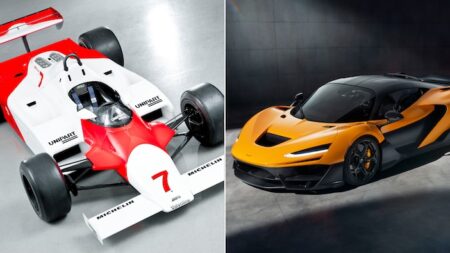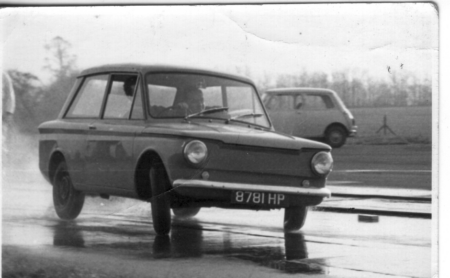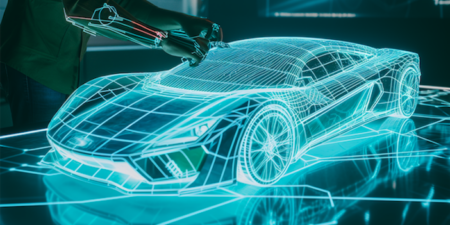With the increasing demand for fuel efficiency and lower emissions, hybrid vehicles (HVs) and electric vehicles (EVs) are already growing in popularity. However, to enable these vehicles to have a wider appeal, it is necessary to provide additional enhancements to differentiate from the competition, rather than having to rely solely on the advantages of reduced emissions.
The first generation of HVs and EVs have adopted the same architecture as conventional fuel-driven vehicles, with one single central motor that transfers power through a standard driveline. However, the application of twin electric motors provides the opportunity for enhancing the handling performance of HVs and EVs. As a result, engineers at Horiba Mira have been working on a piece of technology that aims to exploit this opportunity.
Since 2008, Horiba MIRA has been developing a yaw motion control device, named Electric Dynamic Control (eDC), which uses twin electric motor torque vectoring. The first version of the eDC system was installed on Horiba MIRA’s H4V demonstrator.
“In its original guise, our eDC device was applied to a front-wheel-drive Škoda Fabia that had been modified to include twin electric motors on the rear wheels,” explains Tim Pulford, lead engineer, chassis engineering, Horiba MIRA. “H4V was originally developed as a powertrain demonstrator featuring an on-demand four-wheel-drive mode, as well as a full EV option.
“We retained the front-wheel-drive engine and gearbox; however, the engine was reconfigured to deliver more torque over a narrower speed range, while engaging the gears through a Horiba Mira controlled automated manual transmission (AMT). Acceleration and braking were supported using the high-torque rear-wheel motors and, while the engine was running, an integrated generator charged the advanced batteries.
“The project’s results were positive, with multiple areas providing greater improvements than were aimed for. This included a 40% reduction in CO2 during the EC drive cycle, producing only 104g of CO2 per kilometer, and fuel economy was in excess of 64mpg, compared with the standard 42.2mpg in the baseline vehicle.
“With the emissions results of the H4V project proving successful, it was considered an ideal platform on which to trial the eDC system. With the appropriate HV architecture already in place, all that was necessary was to add an inertial measurement unit, a steering wheel angle sensor, and to implement the eDC control system onto the vehicle.”
Initial trials of the eDC system on the H4V demonstrator also
proved successful, with the ability to mitigate understeer and to improve agility and yaw damping during avoidance maneuvers. However, there was still more work to be done on refining the performance of the eDC system.
Horiba MIRA therefore embarked on the next phase of the project, known as eDC2, to develop a more optimized package. The critical objective of eDC2 was to enhance the dynamic performance of an entry-level conventional fuel vehicle using hybrid technology, while the design, manufacture and integration of the system was to be as close to production level as feasible.
The engineering team chose a Jaguar XF 2.2 diesel as the base vehicle and initially benchmarked it against a performance version of the same model.
Above: The electronic dynamic control (eDC) unit in a subframe
The concept of the eDC2 is a torque vectoring system and, similarly to H4V, it also uses two in-board electrical motors to provide dynamic control, increased performance, and the option to increase efficiency. However, this time the motors are installed in series with the IC powertrain on the rear driveshafts.
The two motors are independently controlled and can be commanded in opposing-phase to generate a yaw moment, which controls the vehicle’s yaw motion to achieve a target value. They can also be commanded in-phase to provide driveability features such as zero-emissions driving, increased acceleration and regenerative braking.
The use of the electric motors to control the yaw moment of the vehicle is unique to this project and is covered by patent number EP20110729646.
To develop eDC2, Horiba MIRA’s Vehicle Engineering Product Group leveraged the expertise of its controls and electronics, simulation, vehicle dynamics, design and prototype build teams. By harnessing the expertise of each of these teams, Horiba Mira was able to develop the eDC2 system entirely in-house.
The design team created the electronic differential (e-diff) assembly, which mounts the twin motors between the conventional driveshafts and the differential unit. Clutches are used to engage the motors, enabling the eDC2 control system to deliver the required torque from the motors to the rear wheels. The team then packaged the e-diff and twin motors into a bespoke rear subframe. Concurrently, the controls and electronics department was responsible for the development of the control system and the bespoke battery.
Finally, the prototype build department manufactured and assembled the e-diff and subframe assemblies and produced a number of bespoke solutions to house the required electrical control hardware and integrate it into the vehicle.
The vehicle dynamics team managed the targets for the project, which were based on the benchmark results of the performance XF, and took responsibility for ensuring these targets were met. During this phase, a full suite of tests was completed on Horiba MIRA’s latest kinematics and compliance test rig.
The simulation team used VI-CarRealTime software to provide a real-time vehicle simulation environment for the eDC2 vehicle based on the base vehicle’s benchmark data. This software was used to determine the suspension characteristics required to cope with the additional mass of the battery and motors, and to simulate the dynamic behavior of the vehicle when the eDC2 control system is active. Through co-simulation with Simulink, VI-CarRealTime was also used to develop the features of the control system.
Pulford reflects on eDC2’s ability: “One of the great features of the eDC2 system is that the dynamics of the vehicle can be enhanced without the need for additional energy consumption or the need to increase battery capacity. This is because the wheel with a negative torque demand regenerates the power required by the wheel with the positive torque demand. Therefore, during system interventions, the battery needs only to provide the small amount of power lost due to the regeneration efficiency.”
When driving at the limits of handling and approaching understeer, the front tires of the vehicle are deeply saturated and will not respond to further steering inputs. With eDC active, the understeer gradient is reduced by increasing the rear slip-angles in a controlled manner, delaying the onset of front tire saturation.
Through a dash-mounted human-machine interface (HMI), the driver is currently able to select two modes: eDC, which supplements the IC powertrain with the eDC function; and Sport, which provides a performance boost by using the twin motors to add drive torque in parallel with the IC powertrain with eDC active. Ultimately, there will also be an EV-only mode, which will provide electric-only drive with or without eDC2 active.
In eDC mode, the lateral dynamics of the vehicle are significantly improved, with the understeer mitigation, increased agility and better yaw damping providing a more rewarding driving experience. In Sport mode, performance can be boosted by adding 50kW (circa 67bhp) to the overall powertrain, reducing the time taken to accelerate from 0-60mph by about three seconds.
In addition to the improved vehicle dynamics performance, Horiba MIRA has been able to reduce the vehicle’s CO2 rating through hybridization and the regenerative braking and control strategies of eDC2, potentially achieving less than 50g per km of CO2. Until technologies improve to enable better packaging and vehicle control, eDC2 provides a useful example for vehicle manufacturers to learn from and adapt to their own hybrid powertrains.
John Miles’s view:
Asked his opinion on this setup, VDI technical editor John Miles says, “Horiba Mira has developed an interesting system. Apart
from significantly improving fuel efficiency and performance when needed, the dual electric motors permit individual rear wheel torque management leading to controllable yaw behavior/damping at all speeds. Better steering feel may also result.”




